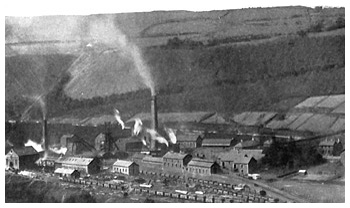
| Penrhiwceiber | |
| The definition of ceibr in the place-name Penrhiwceiber is 'joist, beam or rafter', suggesting a place with trees suitable for being used as roof beams. This reflects the early character of the district, which up until the last twenty years of the 19th century was a heavily wooded area, its steeply sloping hillsides being covered by Penrhiwceiber woods. However the woodland nature of the district was to change with the arrival of the coal industry as the woods were felled and a colliery and terraces of houses took their place. | |
 |
|
Above: This map which was surveyed in 1874-75 illustrates the lack of housing around the colliery and heavily wooded surrounding areas. Aberdare Canal is also shown which was still being used at this date despite the railway going up the valley.
The rapid pace of development can be seen in the census records for 1871 and 1881. In 1871 the village of Penrhiwceiber is not listed, (Confirmed by the map above) however in 1881 the census lists a number of streets within the village of Penrhiwceiber including, Railway Terrace, Quarry Road, Glanlay Street, Rheola Street and Penrhiwceiber Road. The school originally built in 1881 provides further evidence as to the rapid growth of the village, with it having to be enlarged on three separate occasions in 1893, 1895 and 1901. Right: One of the early shops of the new village of Penrhiwceiber |
 |
 |
This growth was to continue into the 20th century until in 1920 the Kelly's Trade Directory was able to list over one hundred commercial properties for Penrhiwceiber, as well as railway stations on both the Great Western and Taff Vale railways, religious buildings including Carmel Chapel (1880), Moriah Chapel, Bethesda Chapel (1885) and St. Winifred's Church (1883) and a Workingmen's Institute and Public Hall built in 1888. Left: Saint Winifred's Church Penrhiwceiber |
| Penrhiwceiber Colliery | |
| Sinking commenced in 1872, the venture being undertaken by John and David Glasbrook and a Mr. Yeo (all of Swansea). Messer's Cory Brothers joined them one year later. Sinking operations proved to be hazardous and great difficulties were encountered due to running sand and water. Several inrushes of water caused holdups and almost led to the abandonment of the undertaking. The installation of a large Cornish beam-type pump allowed the sinking to continue with the nine feet seam of the lower coal being won in 1878. For some years the coal was wound on a single sheave pitch-pine head frame, which was eventually replaced by a steel headgear around 1901. In 1943 a company takeover brought Penrikyber into the Powell Duffryn Group, where it remained until the nationalization of the coal industry in 1947. The colliery was closed in 1985 by British Coal. |
Above: Penrikyber Colliery |
 |
Although sinking of this extensive colliery was started in 1872 it wasn't until July 7th 1879 that the first dram of coal was brought to the surface. The shaft was 658 yards deep with some workings extending around 2 miles from the shaft. At the time this photograph was taken the colliery employed around 1,800 men producing some 8,000 tons of coal weekly. Left: Penrikyber Colliery c1910 |
